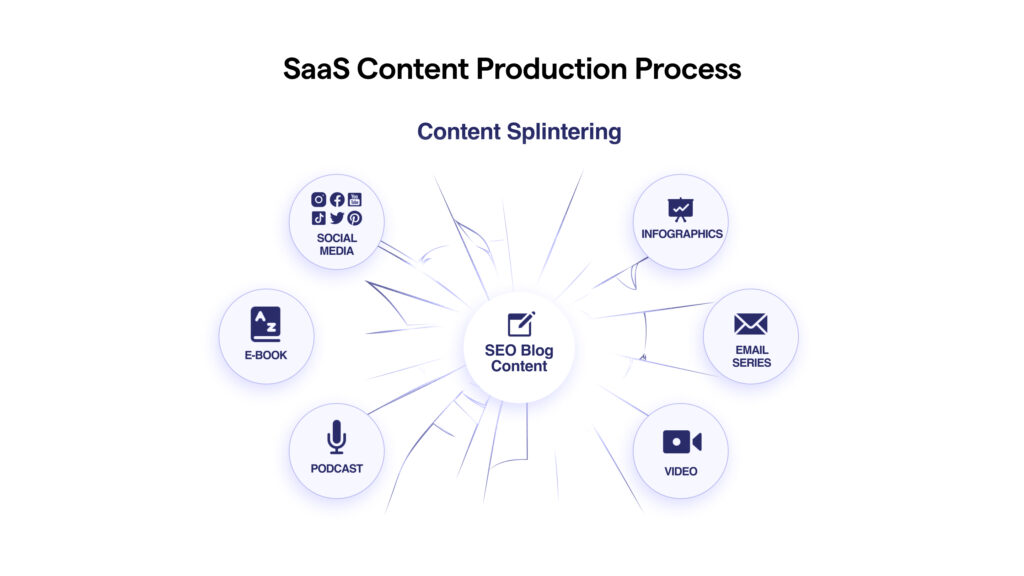
SaaS content marketing is all about carving an authoritative niche for your product to draw in and nurture potential buyers. In their content, SaaS companies must cover multiple touchpoints and move prospects through their journey—providing solutions and educational resources.
What Is SaaS Content Marketing?
At its core, SaaS content marketing is about creating thoughtful and targeted content for potential customers that educates them about the features of your product, addresses their common pain points, and explains how you can solve those problems.
By engaging with prospects through multiple channels and formats, companies can effectively bridge the gap between awareness and purchase decision.
In most B2C applications, content marketing is much more focused on direct response and conversions.
With SaaS applications, however, the focus is more on developing an ongoing relationship with prospects over time to nurture them through their customer journey.
The average SaaS sales cycle lasts 84 days and requires between 7 and 10 touchpoints to achieve.
For SaaS businesses to succeed with content marketing, they must create high-quality content tailored to the needs of their customer base at each stage in the sales funnel.
How does content marketing benefit SaaS companies?
Even in the case of similar or competing products, no two are the same. SaaS content marketing enables organizations to develop their voice, maintain it, and ensure the right leads find and engage with their brand.
1. Ranks businesses for the right keywords and topics.
SaaS keyword research goes much deeper than an Ahrefs data set. It involves understanding the language and the context of your target audience.
By…
- Talking to sales and marketing teams
- Collecting and analyzing customer data
- Creating buyer personas
- Learning how real businesses use your product
…SaaS companies can successfully create keyword and topic clusters that address the specific needs of their customer base.
With time and consistency, they’ll show up in Google results for these keywords, making it easier for prospects to find them.
2. Carves a niche that connects the right buyers with the company.
Even compared to competing products and services, each SaaS product is nuanced in one of the following ways:
- The types of companies they serve
- The members of the company they sell to
- The problems they solve
- The industries and markets they operate in
- The features and advantages their product does best
A SaaS content marketing strategy ensures the organization isn’t just copying and outranking its competitors’ content—it is consistently speaking to the unique set of readers and site visitors who relate to or benefit from its product.
3. Doubles as a sales enablement tool.
By creating content that addresses common problems and demonstrates how your SaaS product solves them, buyers can envision themselves using it.
Publishing content gives target customers a realistic picture of what it’s like to use the software and provides an easy way to explore different features.
4. Ensures consistent engagement across all stakeholders and touchpoints.
Although 86% of B2B decision-makers start their journey with organic search, organic traffic is only a fraction of the total engagements on a SaaS website.
The right content marketing strategy involves developing blog posts, landing pages, white papers, and case studies that appeal to different customer segments and buyer personas throughout the entire process.
5. Builds credibility with industry leaders and professionals.
The best SaaS content marketers (think HubSpot, Salesforce) have industry-wide notoriety because they publish their own research.
When a company curates its unique brand positioning and justifies it with case studies, reports, and original research, it stands out as an industry leader.
By giving back to their customers through content and education, they begin to develop a level of credibility that is impossible to duplicate.
6. Increases organic website traffic and leads.
Since buying behavior starts with a Google search, so, then, does lead generation.
By creating quality content with search engine optimization in mind, SaaS companies increase their organic website traffic and leads.
Effective SaaS Content Marketing Strategies
Every SaaS company is different, but the general principles of effective SaaS content marketing remain the same:
How do you create content for SaaS?

For SaaS companies, achieving content marketing success requires a strategic approach that addresses user intent at every marketing funnel stage, starting with the bottom.
As you work your way up from there, you can effectively engage potential customers and guide them toward conversion.
Building competitor comparison pages
Competitor comparison pages should be the first pieces of content on your website. They help potential customers directly compare your product with competitors, addressing doubts and empowering informed decisions.
86% percent of B2B software buyers use peer review sites to guide their purchase decisions. Competitor pages ensure you show up next to them on search engines and can represent your product to ideal prospects in the way you intend to.
Implementing a free calculator tool
Free calculator tools offer prospects a personalized value proposition, such as potential cost savings or ROI, influencing their purchasing decisions.
User-friendly and visually appealing calculators make complex pricing models, product configurations, and microservices digestible and impactful.
Transitioning to business use cases and problem-solving content
By showcasing the various ways your product can address specific business problems, you can help prospects envision how your software can improve their day-to-day operations, leading to increased interest and engagement in the middle and upper stages of the funnel.
Identify common pain points and showcase how your software solves these problems to increase interest and engagement.
Why is content marketing for SaaS companies different?
SaaS companies require numerous touchpoints with their buyers. And multiple stakeholders are typically engaged in a single purchase.
Software sellers also have built-out sales infrastructure, which requires content as a sales enablement tool.
At the enterprise level, these nuances are even more complicated.
In these ways, businesses face the unique challenges of nurturing leads, driving customer engagement, and creating content that speaks to the distinct needs of various customer segments—all while maintaining consistency and simplicity throughout.
SaaS Content Creation Process

Creating a comprehensive and effective content strategy for your SaaS business involves a multi-channel approach that maximizes the value of your content.
1. Start with SEO-optimized blog posts
Of course, creating blog posts is the first step in any content strategy. These act as the foundation of your content marketing strategy and help to build out a library of content that can lead customers further down the funnel.
Here are a few different blog post types, and how you can use them in your content marketing efforts:
- Bottom-of-the-Funnel (BoFu) Content: Use BoFu content to help marketing qualified leads (MQLs) discover and compare products, research the features and benefits of different solutions, and make informed purchase decisions.
- Middle-of-the-Funnel (MoFu) Content: Your MoFu blog posts and sales pages will focus on bringing awareness to potential solutions and highlighting the features, benefits, and advantages of your product offering.
- Top-of-the-Funnel (ToFu) Content: ToFu content is designed to generate interest in the product. This may include general education posts about topics related to the industry, how-to guides for using a particular feature, or customer success stories.
- Evergreen Content: Evergreen content captures search intent with timeless topics that are relevant to your audience. This content can be used to supplement SEO campaigns and ensure your brand presence is always seen—and clicked on. It can occur at any stage of the marketing funnel and should be regularly updated to ensure accuracy.
2. Repurposing blog content for YouTube
According to Wyzowl’s 2023 State of Video Marketing report, YouTube is the most valuable platform—used by 90% of video marketers.
92% of marketers get a positive ROI from video, and a significant reason for this is that a significant proportion (66%) of your target audience prefers video to written content.
High-converting video content includes:
- Explainer videos
- Product demos for various use cases
- Tutorials for different product features
- Testimonials from existing customers
YouTube videos can be further repurposed for other elements of your omnichannel content marketing strategy, including paid ads, short-form video platforms, and email campaigns.
3. Adapting content for LinkedIn
LinkedIn is a powerful B2B marketing and networking platform, with 82% of B2B marketers achieving their greatest success from it.
To effectively adapt your blog content for LinkedIn, create concise and informative summaries of your blog posts, highlighting key takeaways and insights.
You can also share links to your full blog posts, encouraging users to visit your website for more in-depth information.
SaaS founders should also consider publishing LinkedIn articles to establish their expertise and thought leadership in the SaaS industry.
4. Leveraging content on Twitter
Founders, VPs, and other decision-makers hang out on Twitter (as do users of your product). Twitter provides an excellent opportunity for SaaS companies to engage with their audience in real-time and share bite-sized pieces of content.
Similar to LinkedIn, repurposing your blog content for Twitter involves shortening yoru content to highlight one or two key takeaways. These can include interesting facts, statistics, quotes, or key points from your articles.
You can also use Twitter to share polls and surveys or pose questions relevant to your target audience.
Be sure to use relevant hashtags and mentions to increase the visibility of your tweets and encourage engagement from your followers.
5. Diversify content formats
To further maximize the reach and impact of your SaaS content, consider exploring other content formats like podcasts, infographics, and webinars.
These formats attract highly engaged leads, help you build public relationships with industry leaders, and provide organic SEO backlinks.
You can also use elements of these types of content to generate other content ideas, learn firsthand what your customers are looking for, and inform your overall content marketing strategy.
Grow Your SaaS Business With Content Marketing
Like we mentioned, SaaS content marketing is highly nuanced—getting it down will take some head-scratching and trial-and-error.
And if you don’t have a content team dedicated to growing your business strategically, you might find yourself banging your head against the wall trying to figure out what works and where to start.
That’s why we’re here: To help you nail your SaaS content marketing strategy.
To learn more about how content marketing fits into your overall SEO strategy, check out our SaaS SEO guide. And if you want help from the experts, reach out to us.

Nick Dyer, SEO Analyst
Nick started his SEO journey in 2017. Currently, he resides in Austin, TX. When it comes to his SEO experience, he’s worked with million dollar brands and builds his own affiliate websites in his spare time. One of his greatest passions is travel and trying new foods. He’s been to Italy, Spain, Australia, Greece and more.
